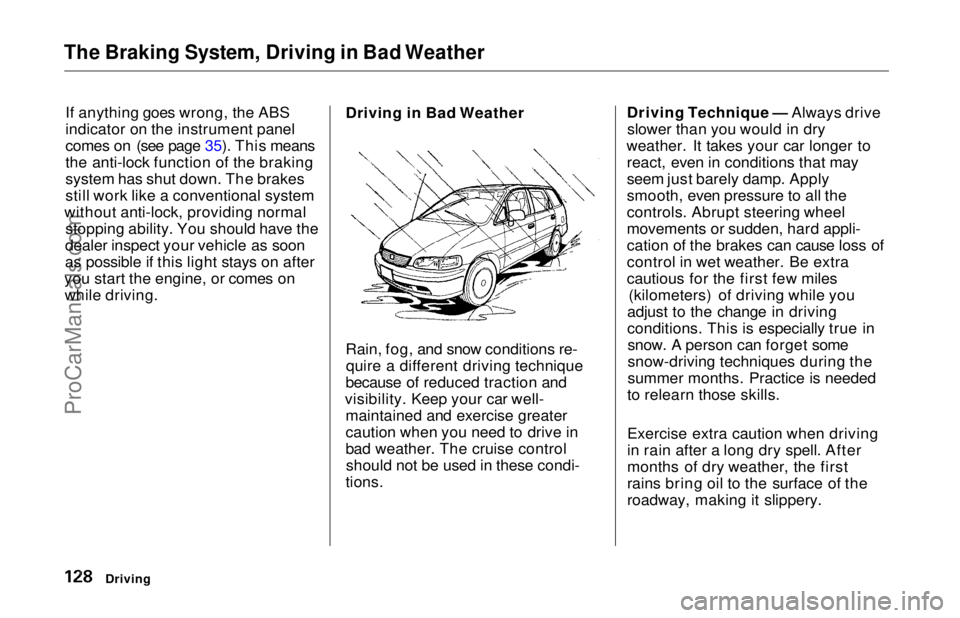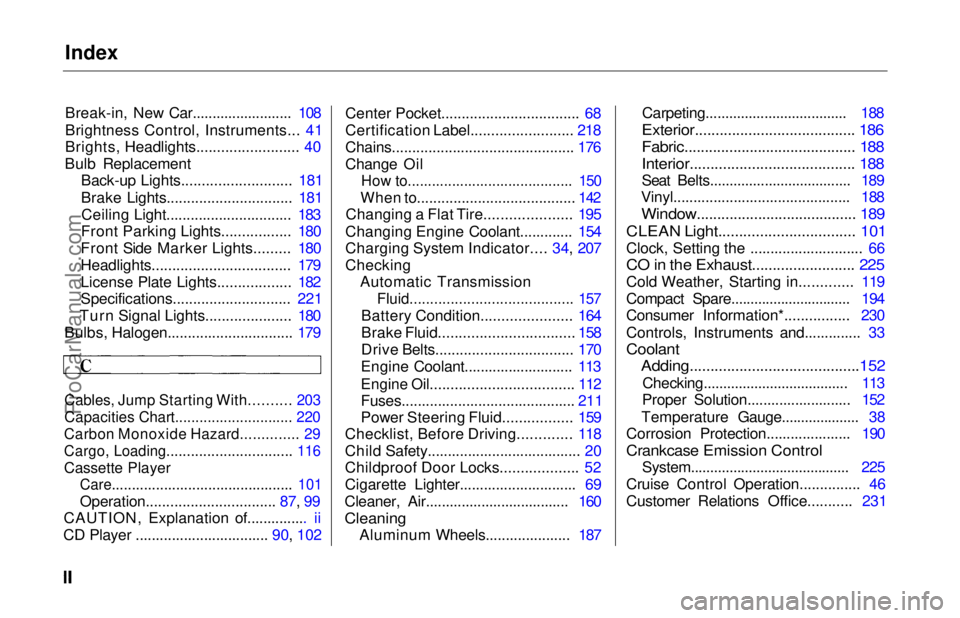Page 128 of 241

The Braking System, Driving in Bad Weather
If anything goes wrong, the ABS
indicator on the instrument panel
comes on (see page 35). This means
the anti-lock function of the braking
system has shut down. The brakes
still work like a conventional system
without anti-lock, providing normal stopping ability. You should have the
dealer inspect your vehicle as soon
as possible if this light stays on after
you start the engine, or comes on while driving. Driving in Bad Weather
Rain, fog, and snow conditions re-
quire a different driving technique
because of reduced traction and
visibility. Keep your car well- maintained and exercise greater
caution when you need to drive in
bad weather. The cruise controlshould not be used in these condi-
tions. Driving Technique — Always drive
slower than you would in dry
weather. It takes your car longer to react, even in conditions that may
seem just barely damp. Apply
smooth, even pressure to all the
controls. Abrupt steering wheel
movements or sudden, hard appli-
cation of the brakes can cause loss of
control in wet weather. Be extra
cautious for the first few miles (kilometers) of driving while you
adjust to the change in driving
conditions. This is especially true in snow. A person can forget some
snow-driving techniques during the
summer months. Practice is needed
to relearn those skills.
Exercise extra caution when driving
in rain after a long dry spell. After
months of dry weather, the first
rains bring oil to the surface of the
roadway, making it slippery.
DrivingProCarManuals.comMain Menu Table of Contents s t
Page 205 of 241
Charging System Indicator
This indicator should come on when the ignition is ON (II), and go out
after the engine starts. If it comes on
brightly when the engine is running, it indicates that the charging system
has stopped charging the battery. Immediately turn off all electrical
accessories: radio, heater, A/C, rear
defogger, cruise control, etc. Try not
to use other electrically-operated
controls such as the power windows. Keep the engine running and take
extra care not to stall it. Starting the
engine will discharge the battery
rapidly. By eliminating as much of the
electrical load as possible, you can drive several miles before the
battery is top discharged to keep the
engine running. Drive to a service station or garage where you can get
technical assistance.
Taking Care of the Unexpected
CHARGING SYSTEM INDICATORProCarManuals.comMain Menu Table of Contents s t
Page 234 of 241

Index
Break-in, New Car......................... 108
Brightness Control, Instruments... 41
Brights, Headlights......................... 40
Bulb Replacement Back-up Lights........................... 181
Brake Lights............................... 181
Ceiling Light............................... 183
Front Parking Lights................. 180
Front Side Marker Lights......... 180
Headlights.................................. 179
License Plate Lights.................. 182
Specifications............................. 221
Turn Signal Lights..................... 180
Bulbs, Halogen............................... 179
Cables, Jump Starting With.......... 203
Capacities Chart............................. 220
Carbon Monoxide Hazard.............. 29
Cargo, Loading............................... 116
Cassette Player
Care............................................. 101
Operation................................ 87, 99
CAUTION, Explanation of............... ii
CD Player ................................. 90, 102 Center Pocket.................................. 68
Certification Label......................... 218
Chains............................................. 176
Change Oil
How to......................................... 150
When to....................................... 142
Changing a Flat Tire..................... 195
Changing Engine Coolant............. 154
Charging System Indicator.... 34, 207
Checking Automatic Transmission
Fluid........................................ 157
Battery Condition...................... 164
Brake Fluid................................. 158
Drive Belts.................................. 170
Engine Coolant........................... 113
Engine Oil................................... 112
Fuses........................................... 211
Power Steering Fluid................. 159
Checklist, Before Driving............. 118
Child Safety...................................... 20
Childproof Door Locks................... 52
Cigarette Lighter............................. 69
Cleaner, Air.................................... 160
Cleaning
Aluminum Wheels..................... 187 Carpeting.................................... 188
Exterior....................................... 186
Fabric.......................................... 188
Interior........................................ 188
Seat Belts.................................... 189
Vinyl............................................ 188
Window....................................... 189
CLEAN Light................................. 101
Clock, Setting the ............................ 66
CO in the Exhaust......................... 225
Cold Weather, Starting in............. 119
Compact Spare............................... 194
Consumer Information*................ 230
Controls, Instruments and.............. 33
Coolant
Adding.........................................152
Checking..................................... 113
Proper Solution.......................... 152
Temperature Gauge.................... 38
Corrosion Protection..................... 190
Crankcase Emission Control
System......................................... 225
Cruise Control Operation............... 46
Customer Relations Office........... 231ProCarManuals.comMain Menu s t